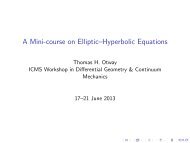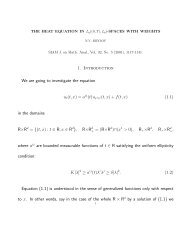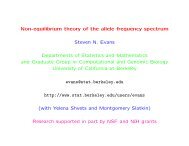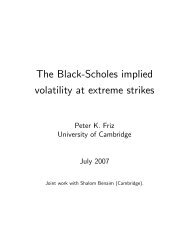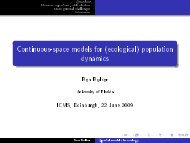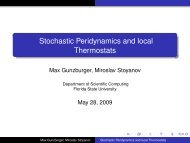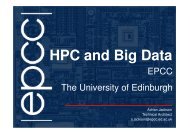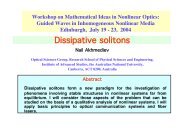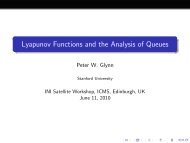Luc TARTAR Compensated Compactness with more ... - ICMS
Luc TARTAR Compensated Compactness with more ... - ICMS
Luc TARTAR Compensated Compactness with more ... - ICMS
Create successful ePaper yourself
Turn your PDF publications into a flip-book with our unique Google optimized e-Paper software.
It would be <strong>more</strong> useful to understand the effective properties<br />
of mixtures for a few properties at the same time, like diffusion<br />
of heat and electricity, magnetic and (linear) elastic properties,<br />
so that it could be used for creating new efficient materials by<br />
selecting adapted microstructures. This seems to require an<br />
improvement of <strong>Compensated</strong> <strong>Compactness</strong>, or H-measures.<br />
In the summer of 1977, at a conference in Rio de Janeiro, I<br />
reported that I had not found a reasonable class of constitutive<br />
relations for Homogenization in “nonlinear” elasticity,<br />
and recalled that since the evolution problem is hyperbolic,<br />
even the stationary solution must satisfy a little <strong>more</strong> than<br />
the “Rankine–Hugoniot condition”, in the sense that some E-<br />
condition must be imposed. Clifford TRUESDELL (1919–2000)<br />
had disagreed <strong>with</strong> my idea that constitutive relations should<br />
be stable under weak convergence, which I thought was obvious<br />
(since one would not call the effective material elastic <strong>with</strong>out<br />
this property), but 10 years later, Owen RICHMOND (1928–<br />
2001) made an observation about higher order gradients for an<br />
effective behaviour (of perforated aluminum plates).<br />
I often say that Γ-convergence is not Homogenization, and that<br />
it deals <strong>with</strong> non-physical questions; in particular, mentioning<br />
only stored energy cannot tell if a material is elastic or not.<br />
The evolution equation for (nonlinear) elasticity is an hyperbolic<br />
system of conservation laws: one must pay attention to<br />
the formation of discontinuities, and to the (physically) admissible<br />
ones; it led Peter LAX to talk about “entropy conditions”,<br />
better called E-conditions after Costas DAFERMOS (since they<br />
often are not related to thermodynamical entropy).<br />
Homogenization teaches to be careful <strong>with</strong> EOS, since they<br />
depend upon which microstructure the material uses.<br />
24




